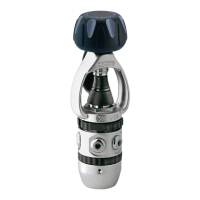ENGLISH
When the diver exhales, he causes the pressure inside the case
The cap of the XS Compact second stage features a larger man-
ual airflow button, with a functional return that is better than pre-
vious regulators in the Cressi-sub line. It also has a special
asymmetrical design in the way the holes are distributed that cal-
ibrates the flow of water in order to better optimize the regulator
performance.
Second stages in the XS Compact line have been designed to
deliver air on demand, that is, only when the diver inhales through
the mouthpiece, creating a light depression inside the regulator.
This light depression, which is slight enough not to cause breath-
ing effort, works in combination with the external pressure to
press against the XS Compact diaphragm, which is properly cal-
ibrated to ensure the best useful working surface. In this way the
breathing effort is kept at the lowest level while the performance
is guaranteed to be the same as that of much larger regulators.
The circular diaphragm, one of the smallest currently on the mar-
ket, is sucked toward the inside of the case when the diver in-
hales, pushing the central Teflon coated plate into contact with a
lever featuring a revolutionary new patented geometry and vari-
able shape, designed to optimize and drastically reduce friction
due to contact between the lever and the diaphragm, by focusing
them in a single point on the plate. Friction between lever and
plate, as happens in other regulators, is therefore avoided, along
with the consequent reduction of the regulator’s performance.
As it descends, the lever opens the air supply valve, which is also
been completely redesigned for maximum manufacturing sim-
plicity compared to previous models.
The air exiting the nozzle on the adjustable valve when the mech-
anism is open is channelled into the injector, which carries it di-
rectly to the mouthpiece. Here, the air is accelerated by the
Venturi effect, causing a vacuum inside the case. In order to pre-
vent the depression from being too violent and sucking in the di-
aphragm, which would lead to free flow, the ends of injector and
case are designed to optimize and direct a light counter-flow of
air towards the diaphragm.
When the air flow inside the injector towards the mouthpiece in-
creases, it is accelerated, as discussed above, by the Venturi effect.
The subsequent depression inside the regulator case keeps the
diaphragm lowered, and virtually eliminates second stage inhala-
tion effort.
The Venturi effect immediately stops as soon as the diver stops
breathing. The diaphragm returns to its normal position, the lever
comes up again pushed by its spring, and the nozzle is closed by
the piston.
In order to enhance the Venturi effect, XS Compact is equipped
with a new ergonomic flow deviator in two modes, which are
clearly shown on the regulator:
fig. 16
67
SECOND STAGES
fig.15 – XS Compact Octopus

